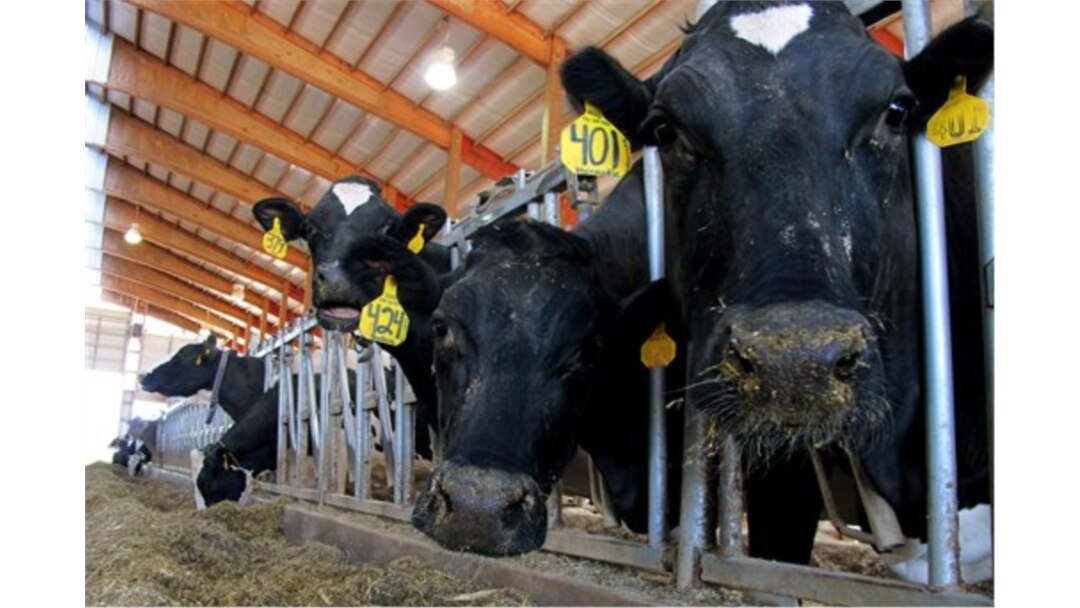Inside a sprawling barn on a farm outside Cambridge, Wisconsin, Tina Hinchley tends to hundreds of cows as part of her daily chores, something that hasn't stopped during the COVID-19 crisis.
"There is huge demand," she said, for the kind of milk produced by Hinchley's cows, which line up, one by one, to an automated machine that collects the product from their udders.
Historically, about 90% of the milk produced on the Hinchley farm supplied Wisconsin's famous cheese industry, which, like everything else in American life, is in upheaval due to the coronavirus.
"When the restaurants, and the schools, and the universities had to close down because of this pandemic, 70% of the milk that was being made into cheese ended up halting production," she told VOA.

FILE - Dairy cows are seen on a farm in Wisconsin in this undated photo.
As more Americans stay home amid restrictions to curb the spread of the coronavirus, grocery and retail stores as well as food banks and charities across the country are struggling to keep up with the increased demand for many food items and essential supplies.
The scarcity of some items in supermarkets has raised concerns about the U.S. food supply. But Hinchley says bare shelves have more to do with logistics than how much food is being produced. She explains it takes time for the food industry to adjust output to meet sudden shifts in consumer behavior – like a surge in demand for cheese portioned and packaged for grocery stores.
"It's going to take time before there is a conversion from a 40-pound block of cheese into string cheese or taking the little single serving pats of butter and making it into more retail selections for the consumer," she said.
"Seldom does a consumer go to a grocery store and want to buy a 5-pound bag of shredded cheese," said Mark Stephenson, director of Dairy Policy Analysis at the University of Wisconsin, Madison. "They wanted maybe 1-pound bags at a time. You can't just put 1-pound bags through a 5-pound line. Not possible. You have to have a different piece of equipment set up differently. We've had an industry that's had to shuffle a great deal to move product from where it was produced before to where it needs to be today."
Which is why some items may not be available on store shelves, a problem Stephenson sees as temporary.
"Mostly the amount of food that has been produced before is being produced now and is generally available to consumers," he said.
FILE - Shelves that usually hold an abundance of chicken and beef lay empty at a Target in Abington, Pennsylvania., March 18, 2020.
"I think there's plenty of goods on farms. The disruption comes in the processing and then also the reorienting of processing," said farmer Brian Duncan, who spoke to VOA via Skype. Duncan said he has enough hogs on his rural Illinois farm to continue supplying pork processors near him.
Earlier this month, a COVID-19 outbreak in South Dakota forced the closure of a processing plant that handles about 5% of America's pork output. More recently, an Iowa facility that processed pork shut down as well.
While those processors and others are cutting or suspending operations, Duncan doesn't foresee long-term shortages of meat products on grocery shelves.
"We hope this disruption on the packing side does not last very long," he said. "I would still be confident that our suppliers, our packers can keep things going well enough to keep the grocery stores stocked, and any disruptions are local in nature and short-term disruptions in just the ability to get the products through the system and into the grocery store."
Added Hinchley, "The product is there, it's the packaging that's the hiccup right now. This is the bump in the chain."
If anything, Hinchley said, her dairy operation is producing too much at this point. While she isn't dumping any milk, she and other dairy farmers across the country may have to reduce their herds to prevent flooding the marketplace with milk that can't be processed.
"We are learning a new way of doing things," Hinchley said. "Things are not the same as they were just a month ago."
Before COVID-19, Americans spent more money eating out than eating in. Now the numbers are reversed, and while food suppliers are struggling to adjust, Hinchley said the crisis has increased the awareness of many Americans of the source, and supply chain, of what they are eating.
"When I go to the grocery store, they're like, 'Wow! I never realized that behind this milk jug were all these other people involved in getting the milk from your farm to me,'" she said. "And, yes, it's definitely more appreciative now than ever."

